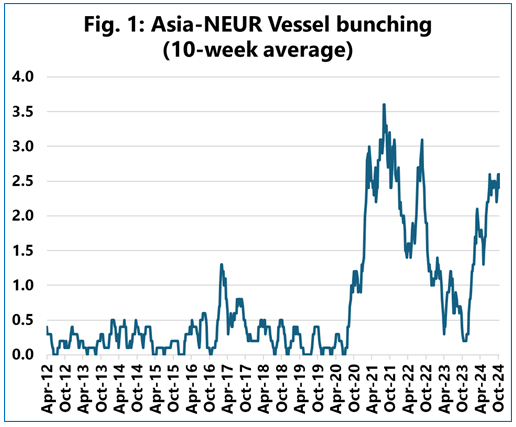In its latest analysis, Sea-Intelligence has dived into the “vessel bunching” phenomenon, which is defined as the number of sailings in a given week in excess of the number of weekly services.
The Danish maritime data analysis firm explains, “From a network design perspective, for every weekly deep-sea liner service, one vessel would be scheduled to depart from an origin region each week. However, in the real world, a shipping line can have multiple vessels departing in the same week, on the same service. This can be caused by vessel delays, where a delayed vessel slides into the following week, vessel shortages where shipping lines deploy two smaller vessels to replace a larger vessel, or because of extra-loader vessels to cater to excess demand/cargo backlog.”
For instance, if there are 17 sailings in one week, and there are 15 weekly services, “vessel bunching” equals 2.

Sea-Intelligence analysts have calculated vessel bunching as an average seen over a rolling 10-week period and took under consideration the Asia-North Europe trade.
In the eight years prior to the pandemic, there was a relatively low level of vessel bunching, whereas the pandemic caused an extreme increase, according to the analysts, who also see a normalization towards the end of 2023. However, the Red Sea crisis has caused a new surge in vessel bunching, back to a level almost matching the pandemic peak.
“Higher vessel bunching creates a larger pressure on ports and terminals,” noted Alan Murphy, CEO of Sea-Intelligence. “While the offered capacity might be the same when seen over two weeks i.e., no vessel sailing in one week followed by two vessels sailing in the following week, having two vessels depart in one week and zero vessels in the second week creates an extraordinarily high workload in one week and none in the second week.”
Murphy points out that this increases the risk of port congestion, and as a ripple effect, a similar crunch on the use of truck, rail, and barge capacity.
“Vessel bunching can therefore be seen as a proxy measure for the pressure on ports and the corresponding likelihood of congestion problems. As such, given the data, there is no indication that the pressure on ports is about to be alleviated,” concluded Murphy.







